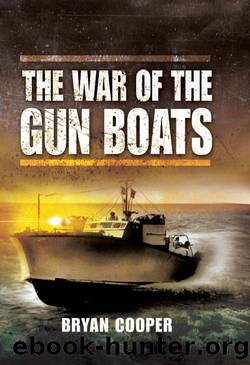The War of the Gun Boats by Bryan Cooper

Author:Bryan Cooper [Cooper, Bryan]
Language: eng
Format: epub
ISBN: 9781848840188
Publisher: Pen & Sword Books
Published: 2012-09-15T00:00:00+00:00
With the landings on New Georgia, the advance PT bases now moved forward. Apart from that already operational at Rendova Harbour to cover the western area, another was established at Lever Harbour on the north-east coast of New Georgia to cover the eastern area. The main activity of the PTs was now directed at barge hunting, following the first brushes with this type of craft by Rendova-based PTs on 21 July, and Lever boats on 3 August.
The barges were tough opponents â they were so well armoured that gunfire was often ineffective against them. And they were not slow in returning fire, closing the PTs should their attack slacken or stop for reloading. The PT commanders learned the value of having supporting PTs available to cover a retiring boat. At the same time the Japanese also countered these attacks by mounting heavier guns on the barges â up to 40mm â and installing shore batteries along the barge routes. This led to the decision to equip some PTs with 37mm and 40mm guns, and additional armour, making up for the increased weight by the removal of torpedo tubes and depth charges. Their role became that of gunboats, just as in similar circumstances the MA/SBs of British Coastal Forces in the North Sea had been converted to MGBs, often fighting within range of German shore batteries.
But there the comparison ended. Had the Japanese developed fast motor torpedo boats to the same extent as the other major powers, the Pacific campaigns would have provided ideal opportunities in which to use them, both to combat the PTs and to ferry men and materials amongst the islands, as did the Americans. But they were hampered by a severe shortage of petrol engines, the main reason for their lack of MTB development. Also, the Japanese had to concentrate on other priorities, such as building destroyers, with the result that when these had to be withdrawn because of their vulnerability to attack, barges were the only other alternative, although, considerably armed as they were, they did not have the speed of the PTs with which to avoid attack. The result was that from the beginning, the PTs established a clear ascendancy over them. By the end of August, during ninety-nine engagements against barges, the PTs claimed eleven sunk or destroyed, and twenty-five damaged; by the end of the year, another fifteen were sunk and twenty-one damaged. As it turned out, these claims, unlike some of those made against enemy destroyers, were proved to be conservative. A number of barges were later found by the advancing US ground forces to have been damaged beyond repair as a result of these engagements, and run up on beaches and reefs. And, of equal importance, the presence of the PTs alone was often sufficient to compel the enemy to turn back from attempts to reinforce his island bases.
The PTs had no such problem and were often used for transporting parties of Army and Marine forces to take over the smaller islands, and to carry out reconnaissance for major landings.
Download
This site does not store any files on its server. We only index and link to content provided by other sites. Please contact the content providers to delete copyright contents if any and email us, we'll remove relevant links or contents immediately.
Small Unmanned Fixed-wing Aircraft Design by Andrew J. Keane Andras Sobester James P. Scanlan & András Sóbester & James P. Scanlan(32763)
Navigation and Map Reading by K Andrew(5133)
Endurance: Shackleton's Incredible Voyage by Alfred Lansing(4719)
And the Band Played On by Randy Shilts(2165)
The Box by Marc Levinson(1965)
Top 10 Prague (EYEWITNESS TOP 10 TRAVEL GUIDES) by DK(1957)
Wild Ride by Adam Lashinsky(1951)
The Race for Hitler's X-Planes: Britain's 1945 Mission to Capture Secret Luftwaffe Technology by John Christopher(1837)
The One Percenter Encyclopedia by Bill Hayes(1811)
Trans-Siberian Railway by Lonely Planet(1725)
Girls Auto Clinic Glove Box Guide by Patrice Banks(1707)
Bligh by Rob Mundle(1676)
Looking for a Ship by John McPhee(1651)
Good with Words by Patrick Barry(1641)
Batavia's Graveyard by Mike Dash(1633)
TWA 800 by Jack Cashill(1625)
Fighting Hitler's Jets: The Extraordinary Story of the American Airmen Who Beat the Luftwaffe and Defeated Nazi Germany by Robert F. Dorr(1610)
Troubleshooting and Repair of Diesel Engines by Paul Dempsey(1578)
Ticket to Ride by Tom Chesshyre(1567)
